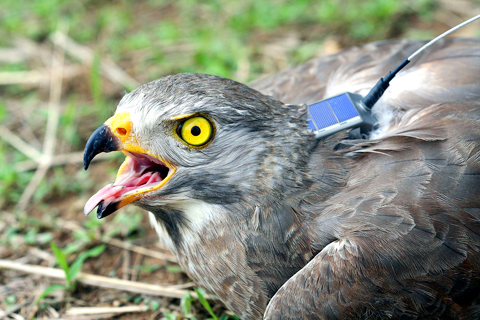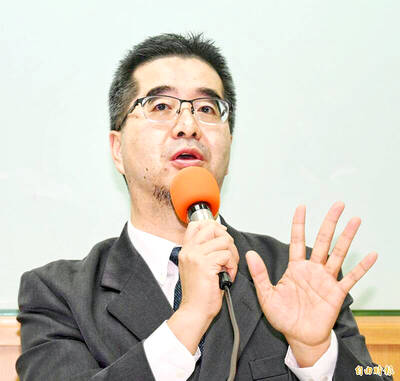After eight months of research, Taiwanese raptor experts recently completed tracing the migration pattern of the endangered gray-faced buzzard, an Asian bird of prey, the Forestry Bureau said on Thursday.
A research study sponsored by the bureau shows that gray-faced buzzards, or Butastur indicus, stop over in Taiwan every October on their way south to winter in southern areas of the Philippines.
The raptors then fly north in the spring, making another stop in Taiwan before continuing their migration to the China-Russia border near China's Heilongjiang Province or North Korea to breed, the findings show.

PHOTO: CNA
Between 15,000 and 35,000 gray-faced buzzards visit Taiwan during these spectacular migrations, but prior to the latest study, knowledge of where the birds came from and where they went was scant.
Keen to find out more about the birds' migration patterns, the research team, including researchers from Academia Sinica and the non-profit Raptor Research Group of Taiwan, fitted satellite trackers on several adult buzzards to find out more about their habits.
The findings solved part of an old puzzle surrounding the birds, said Lin Wen-hung (林文宏), the secretary-general of the Raptor Research Group of Taiwan.
“The migration pattern that we have discovered, however, does not mean that all gray-faced buzzards use the same route for their annual migrations,” Lin said.
The gray-faced buzzard is listed in Appendix II of the Convention on International Trade in Endangered Species of Wild Flora and Fauna (CITES) and is also protected by inclusion as a Rare and Valuable Species under Taiwan's Wildlife Conservation Act, the Forestry Bureau said.
Generally, the southern migration areas of gray-faced buzzards are limited to Southeast Asia. In summer, they breed in eastern areas of Asia, including northern China, the Korean peninsula, an area southeast of the River Ussuri in Russia and Japan. When autumn comes, they migrate south to southeastern China, Indochina, the Philippines, Borneo, the Celebes and New Guinea, although the migration routes are still not clear.
Japanese researchers were the first to carry out a satellite positioning plan for tracing the buzzards. They marked and released several of the raptors from the Japanese island of Ishigaki, hoping that they would fly south — the birds headed north instead.
Last October, the Taiwanese team fitted satellite trackers to five adult gray-faced buzzards caught in Kenting National Park and the Mt Bagua National Scenic Area in Changhua County.
The five birds were dubbed Cape Nos. 1 to 5 and then released. The researchers lost contact with Cape No. 3 and No. 4 somewhere over the ocean as the birds were flying north and their transmitters remained silent, the bureau said.
The other three — Cape No. 1, No. 2 and No. 5 — continued transmitting signals, showing the precise locations of their travel routes and unveiling their hitherto mysterious migration routes.
Cape No. 1 was found to have traveled more than 9,000km in a broad circle covering the southern Philippines at the southernmost location and Heilongjiang Province at the northernmost tip, with Taiwan as a midway stop and a mountainous area in China's northeastern Jilin Province as its breeding ground early last month, bureau officials said.
The bird took refuge on a tiny island off China's Guangdong Province in March under the strong northeast monsoon, where it recovered its strength before heading further north around the end of May.
Cape No. 2 and No. 5 also flew more than 9,000km in a migration circle, breeding in a rural area of North Korea.
The recent finding — the first migration data on gray-faced buzzards — has set up a good scientific foundation for further migration research, the officials said.
“Further and more detailed research will help us find out more about the birds,” Lin said.

The Coast Guard Administration (CGA) yesterday said it had deployed patrol vessels to expel a China Coast Guard ship and a Chinese fishing boat near Pratas Island (Dongsha Island, 東沙群島) in the South China Sea. The China Coast Guard vessel was 28 nautical miles (52km) northeast of Pratas at 6:15am on Thursday, approaching the island’s restricted waters, which extend 24 nautical miles from its shoreline, the CGA’s Dongsha-Nansha Branch said in a statement. The Tainan, a 2,000-tonne cutter, was deployed by the CGA to shadow the Chinese ship, which left the area at 2:39pm on Friday, the statement said. At 6:31pm on Friday,

The Chinese People’s Liberation Army Navy’s (PLAN) third aircraft carrier, the Fujian, would pose a steep challenge to Taiwan’s ability to defend itself against a full-scale invasion, a defense expert said yesterday. Institute of National Defense and Security Research analyst Chieh Chung (揭仲) made the comment hours after the PLAN confirmed the carrier recently passed through the Taiwan Strait to conduct “scientific research tests and training missions” in the South China Sea. China has two carriers in operation — the Liaoning and the Shandong — with the Fujian undergoing sea trials. Although the PLAN needs time to train the Fujian’s air wing and

Taiwanese celebrities Hank Chen (陳漢典) and Lulu Huang (黃路梓茵) announced yesterday that they are planning to marry. Huang announced and posted photos of their engagement to her social media pages yesterday morning, joking that the pair were not just doing marketing for a new show, but “really getting married.” “We’ve decided to spend all of our future happy and hilarious moments together,” she wrote. The announcement, which was later confirmed by the talent agency they share, appeared to come as a surprise even to those around them, with veteran TV host Jacky Wu (吳宗憲) saying he was “totally taken aback” by the news. Huang,

The American Institute in Taiwan (AIT) put Taiwan in danger, Ma Ying-jeou Foundation director Hsiao Hsu-tsen (蕭旭岑) said yesterday, hours after the de facto US embassy said that Beijing had misinterpreted World War II-era documents to isolate Taiwan. The AIT’s comments harmed the Republic of China’s (ROC) national interests and contradicted a part of the “six assurances” stipulating that the US would not change its official position on Taiwan’s sovereignty, Hsiao said. The “six assurances,” which were given by then-US president Ronald Reagan to Taiwan in 1982, say that Washington would not set a date for ending arm sales to Taiwan, consult